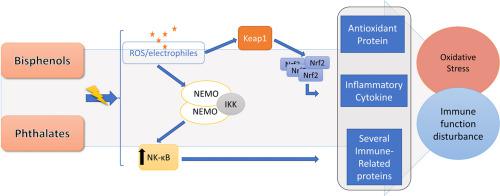Journal of Hazardous Materials ( IF 13.6 ) Pub Date : 2021-06-17 , DOI: 10.1016/j.jhazmat.2021.126426 Mario Alberto Burgos-Aceves 1 , Haitham G Abo-Al-Ela 2 , Caterina Faggio 3

|
The invertebrate innate immunity is a crucial characteristic that represents a valuable basis for studying common biological responses to environmental pollutants. Cell defence mechanisms are key players in protecting the organism from infections and foreign materials. Many haemocyte-associated immunological parameters have been reported to be immunologically sensitive to aquatic toxins (natural or artificial). Environmental plastic pollution poses a global threat to ecosystems and human health due to plastic vast and extensive use as additives in various consumer products. In recent years, studies have been done to evaluate the effects of plasticizers on humans and the environment, and their transmission and presence in water, air, and indoor dust, and so forth. Hence, the development of biomarkers that evaluate biological responses to different pollutants are essential to obtain important information on plasticizers’ sublethal effects. This review analyses the current advances in the adverse effects of plasticizers (as emerging contaminants), such as immunological response disruption. The review also shows a critical analysis of the effects of the most widely used plasticizers on haemocytes. The advantages of an integrative approach that uses chemical, genetic, and immunomarker assays to monitor toxicity are highlighted. All these factors are imperative to ponder when designing toxicity studies to recognize the potential effects of plasticizers like bisphenol A and phthalates.
中文翻译:

邻苯二甲酸盐和双酚类增塑剂对水生无脊椎动物血细胞免疫功能的影响:生理、生化和基因组方面的综述
无脊椎动物先天免疫是研究对环境污染物的常见生物反应的宝贵基础。细胞防御机制是保护生物体免受感染和外来物质侵害的关键因素。据报道,许多与血细胞相关的免疫学参数对水生毒素(天然或人工)具有免疫敏感性。由于塑料被广泛广泛用作各种消费品的添加剂,环境塑料污染对生态系统和人类健康构成了全球威胁。近年来,已有研究评估增塑剂对人类和环境的影响,以及它们在水、空气和室内灰尘等中的传播和存在。因此,开发评估对不同污染物的生物反应的生物标志物对于获得有关增塑剂亚致死效应的重要信息至关重要。本综述分析了增塑剂(作为新兴污染物)的不利影响的当前进展,例如免疫反应破坏。该评论还对最广泛使用的增塑剂对血细胞的影响进行了批判性分析。强调了使用化学、遗传和免疫标记分析来监测毒性的综合方法的优势。在设计毒性研究以识别双酚 A 和邻苯二甲酸盐等增塑剂的潜在影响时,必须考虑所有这些因素。本综述分析了增塑剂(作为新兴污染物)的不利影响的当前进展,例如免疫反应破坏。该评论还对最广泛使用的增塑剂对血细胞的影响进行了批判性分析。强调了使用化学、遗传和免疫标记分析来监测毒性的综合方法的优势。在设计毒性研究以识别双酚 A 和邻苯二甲酸盐等增塑剂的潜在影响时,必须考虑所有这些因素。本综述分析了增塑剂(作为新兴污染物)的不利影响的当前进展,例如免疫反应破坏。该评论还对最广泛使用的增塑剂对血细胞的影响进行了批判性分析。强调了使用化学、遗传和免疫标记分析来监测毒性的综合方法的优势。在设计毒性研究以识别双酚 A 和邻苯二甲酸盐等增塑剂的潜在影响时,必须考虑所有这些因素。和用于监测毒性的免疫标志物检测被突出显示。在设计毒性研究以识别双酚 A 和邻苯二甲酸盐等增塑剂的潜在影响时,必须考虑所有这些因素。和用于监测毒性的免疫标志物检测被突出显示。在设计毒性研究以识别双酚 A 和邻苯二甲酸盐等增塑剂的潜在影响时,必须考虑所有这些因素。



























 京公网安备 11010802027423号
京公网安备 11010802027423号